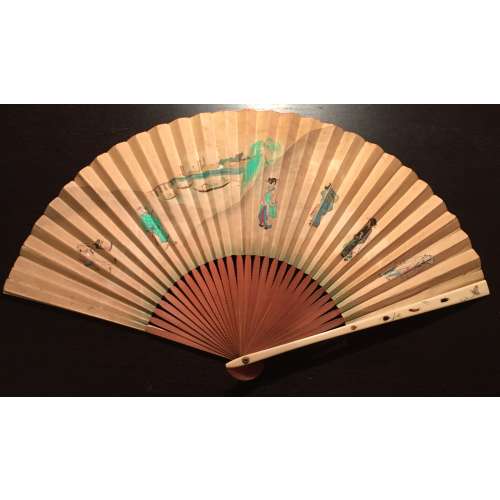-
 NEWArtist: Kawanabe Kyōsai [河鍋 暁斎] (Japanese, 1831 – 1889) Signed: Seisei Kyosai [惺々暁斎], and sealed. Media: Fan print (uchiwa-e, 団扇絵), 215 x 233 mm. Publisher: Unknown / No seal Date: Unknown / No seal Media: Fan print (uchiwa-e, 団扇絵), 215 x 233 mm. Possibly, a private order. Wind chimes (fûrin, 風鈴) are associated with a Wind Chimes Festival [風鈴祭り], held in summer all over Japan. Seller's description: wo swallows streak by with seeming joy past a fûrin, a wind bell. These Japanese wind chimes were introduced to Japan in the Heian era, and in the Edo period, they began to be constructed out of glass. We see the hanging length of paper twisting in the breeze as it creates a delightful chime; these tones are a characteristic sound of summer in Japan. A layer of deluxe mica covers the entire design, lending sparkle. This work was meant to be pasted onto an uchiwa, or fan, for summer use.
NEWArtist: Kawanabe Kyōsai [河鍋 暁斎] (Japanese, 1831 – 1889) Signed: Seisei Kyosai [惺々暁斎], and sealed. Media: Fan print (uchiwa-e, 団扇絵), 215 x 233 mm. Publisher: Unknown / No seal Date: Unknown / No seal Media: Fan print (uchiwa-e, 団扇絵), 215 x 233 mm. Possibly, a private order. Wind chimes (fûrin, 風鈴) are associated with a Wind Chimes Festival [風鈴祭り], held in summer all over Japan. Seller's description: wo swallows streak by with seeming joy past a fûrin, a wind bell. These Japanese wind chimes were introduced to Japan in the Heian era, and in the Edo period, they began to be constructed out of glass. We see the hanging length of paper twisting in the breeze as it creates a delightful chime; these tones are a characteristic sound of summer in Japan. A layer of deluxe mica covers the entire design, lending sparkle. This work was meant to be pasted onto an uchiwa, or fan, for summer use. -
 Artist: Utagawa Kuniyoshi [歌川 國芳] (Japanese, 1798 – 1861). Publisher: Enshuya Matabei [遠州屋又兵衛] (Japanese, fl. c. 178 – 1881) – no seal, ref: Kunisada Project. Title: A Summer Evening [夏乃夕暮] (Natsu no Yūgure). A young woman in purple kimono decorated with cranes and waves catching a firefly among yellow and purple flowers. Signed: Ichiyosai Kuniyoshi ga [一勇斎 国芳 画] in a red cartouche and sealed with paulownia (kiri mon). Date seal and double nanushi censor seals: Fuku & Muramatsu, 1853 (Kaei 6, 2nd month). No publisher's seal. Size: Uchiwa-e (untrimmed fan print) 228 x 296 mm. The yellow flower is probably Patrinia scabiosifolia (ominaeshi) [女郎花]. The purple flower seems to be Platycodon grandiflorus or Balloon Flower (kikyō) [桔梗]. Besides, there are visible panicles of Miscanthus sinensis, or Japanese pampas grass (susuki) [薄]. These three are part of the Seven Grasses of Autumn (aki no nanakusa) [秋の七草].
Artist: Utagawa Kuniyoshi [歌川 國芳] (Japanese, 1798 – 1861). Publisher: Enshuya Matabei [遠州屋又兵衛] (Japanese, fl. c. 178 – 1881) – no seal, ref: Kunisada Project. Title: A Summer Evening [夏乃夕暮] (Natsu no Yūgure). A young woman in purple kimono decorated with cranes and waves catching a firefly among yellow and purple flowers. Signed: Ichiyosai Kuniyoshi ga [一勇斎 国芳 画] in a red cartouche and sealed with paulownia (kiri mon). Date seal and double nanushi censor seals: Fuku & Muramatsu, 1853 (Kaei 6, 2nd month). No publisher's seal. Size: Uchiwa-e (untrimmed fan print) 228 x 296 mm. The yellow flower is probably Patrinia scabiosifolia (ominaeshi) [女郎花]. The purple flower seems to be Platycodon grandiflorus or Balloon Flower (kikyō) [桔梗]. Besides, there are visible panicles of Miscanthus sinensis, or Japanese pampas grass (susuki) [薄]. These three are part of the Seven Grasses of Autumn (aki no nanakusa) [秋の七草]. -
 Late 19th-century (1850-1870) Japanese export fan. This fan has a double leaf painted with a different design on either side. Ivory encrusted with gemstones and other materials. Subject matter such as women wearing kimono is also more typical of export than domestic products (V&A). Summer (birds and flowers) theme on the reverse.
Late 19th-century (1850-1870) Japanese export fan. This fan has a double leaf painted with a different design on either side. Ivory encrusted with gemstones and other materials. Subject matter such as women wearing kimono is also more typical of export than domestic products (V&A). Summer (birds and flowers) theme on the reverse.


